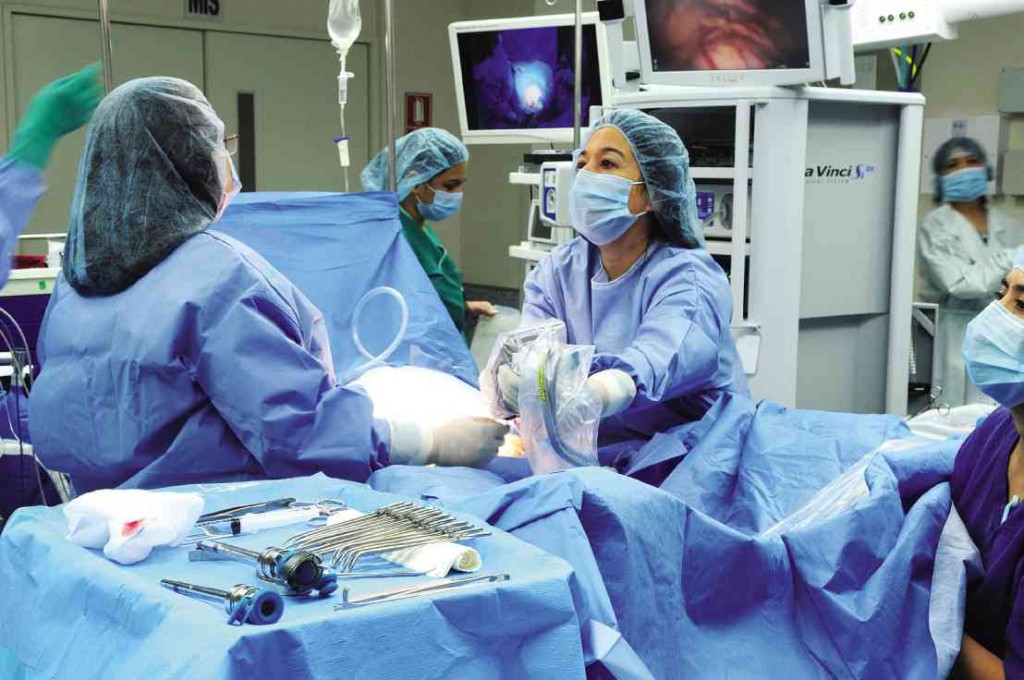Minimally invasive surgery, in the form of laparoscopic surgery, was introduced in the country in 1993. This brought great strides in shifting major pelvic surgery from an open-incision approach to a band-aid-incision approach. The technology finally arrived where women did not have to suffer through huge, painful surgical incisions and could get back to work with very little time for recovery.
However, there were still limitations to laparoscopic surgery because of the nature of instrumentation. Although laparoscopic surgery utilized small incisions through which straight instruments that open and close to perform surgery, the surgeon had to remain standing beside patient to physically move instruments, causing surgeon fatigue during long, difficult procedures.
Furthermore, movements in laparoscopic surgery were counterintuitive to the human brain. This was because when an instrument is put inside the patient’s abdomen, for the tip of the instrument to go forward, one had to move the instrument backward, and to move the tip to the left, the surgeon had to move the handle to the right, all these while looking at a flat screen 2-D monitor that eliminated depth perception. This made it very difficult to teach the brain to adapt to this mirror-image movement, which explains the slow pace at which gynecologists embraced the technology in the country.
To date, there are only 126 gynecologic laparoscopists certified by the Philippine Society for Gynecologic Endoscopy out of about 3,500 certified OB-Gyn Fellows by the Philippine Obstetric and Gynecologic Society. Of the certified laparoscopists, only four have moved up to receive international accreditation in robotic surgery.
The advent of the Da Vinci Robot provided surgeons with a tool to carry out more complex, minimally invasive procedures. This was mainly because the robot had three main components, which took surgery to another cutting-edge level. The first component was the patient cart, which had four arms and were docked to the patient to hold the instruments through 0.8- to 1.2-cm incisions. The instruments had a revolutionary Endowrist technology which allowed rotation (laparoscopic instruments could only open and close), and had seven degrees of freedom of movements, surpassing the articulation of the human hand.
Second component is the Surgeon’s Console located away from the patient, which ergonomically seats the surgeon according to personal preference of elbow height, head angle and foot pedal adjustments. With joysticks, the surgeon can control instruments precisely inside the patient’s abdomen and perform surgery while robot software filters out any tremors from the surgeon’s hand.
Third component is the Vision System, which offers the surgeon a three-dimensional view of the surgical field while magnifying structures 10 to 15 times higher than the naked eye! This feature enables better precision in differentiating small nerves and vessels, which need to be avoided during dissection. The Robotic camera clearly offers a superior advantage from the limitation of laparoscopic camera that allows only a two-dimensional picture, thus disabling depth perception and magnifies view up to six times only to maintain focus.
There are nearly 3000 Da Vinci robots installed all over the world, two-thirds of which are located in the United States. Since 2001, when the US Food and Drug Administration (FDA) approved the use of the Da Vinci robot for prostatectomy (removal of the male prostate, usually for prostate cancer), there has been a rapid decline in open surgery for prostatectomy. This is because the magnification and precision of anatomic dissection with the robot allows the surgeon to isolate the nerves and vessels that preserve the erection and ability of the male patient to hold urine after surgery. Loss of erection and incontinence were feared major complications, which were common with open surgery prior to robotic technology. Currently, 87 percent of prostatectomies in the United States are done robotically. Robotic prostatectomy has indeed overtaken open surgery as the gold standard for the removal of prostate cancer.
In the field of gynecology, after the US FDA approval of Da Vinci robot for hysterectomy in 2005, there was surge of robotic hysterectomies such that to date, 76 percent of hysterectomies for cancer in the United States, are now done robotically because of improved patient outcomes. Open hysterectomy for benign or malignant reasons is resorted to only in 20-21 percent of cases.
At St Luke’s Global City Medical Center, to date, over 330 robotic surgery cases have been accomplished. Two-thirds of these cases were gynecologic. It is, in fact, the fastest-growing private gynecologic robotics program in Southeast Asia. Complication rates are extremely low and patient outcomes are very good.
Robotics technology is here to stay, and newer upgrades in the near future will only facilitate improved flexibility and reduced bulk of the machine, providing greater versatility and better access of the surgical field by the surgeon. What was once thought as science fiction is now available to Filipinos in a local setting and at a price lower than most countries all over the world where the robots are currently installed.
Rebecca B. Singson, MD, Fellow, POGS, ACS, AAGL, PSGE, PSCPC, is an internationally certified robotic surgeon. She practices robotic surgery at St. Luke’s Global Medical Center for symptoms related to the female reproductive organ. Her advocacy is to inform women that there’s a shorter time of recovery with robotic procedures.
